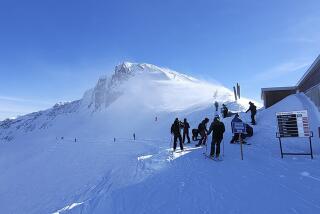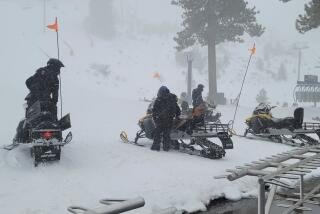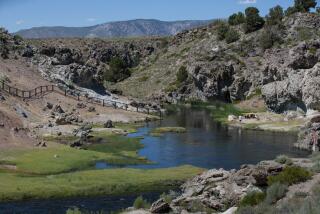On Mt. Juneau’s slopes, it’s a year to watch your back
- Share via
JUNEAU, ALASKA — Carroll “Butch” Holst and his wife, Janice, were thrilled in 1978 when they bucked a tight housing market and sealed a deal on a cozy, affordable home at the foot of Mt. Juneau. Thrilled, that is, until someone showed them a photograph of their new house in a National Geographic article that tagged their neighborhood as North America’s worst avalanche risk.
“That was our first indication that there was a serious problem,” said Janice, a redheaded dance teacher and grandmother of 12.
Almost 30 years after moving in, she still gets jumpy during winter. Despite her husband’s assurances, the steady barrage of alerts this year from the city’s new Web-based avalanche forecasting system has been unnerving.
Now, with a record snowfall piled up on the mountain and a storm alert prompting city officials to warn that it could let loose, the Holsts recently threw together important papers and clothes, preparing to spend the night at their son’s house in a flatter, safer part of town.
“Butch is losing his energy to say, ‘It’s not going to happen, it’s not going to happen,’ and I’m like a crazy clucking hen running around saying, ‘Everybody get ready, the sky’s going to fall,’ ” said Janice, with a nervous laugh.
Avalanche forecasting is a tricky business in Alaska’s capital, where more than 60 homes, a busy harbor and sections of a main thoroughfare are considered at risk from a dozen chutes that sweep off the steep and burly shoulders of Mt. Juneau.
Avalanches are notoriously difficult to predict, and residents become complacent as years go by without a serious incident.
“I don’t want to make light of it, but why doesn’t the city put barriers up if they are so concerned about it?” said Butch.
The chute above the Holsts’ house has released seven large slides over the last century. The most costly, in March 1962, was an airborne blast of dry powder snow that blew off roofs, knocked houses off their foundations and hurled trees through walls and windows. Amazingly, no one was killed or badly injured, though 17 homes suffered significant damage.
Although avalanches reaching into town are relatively infrequent, specialists say it’s only a matter of time before another big one hits, and it could make the 1962 slide look puny.
Though residents fret about the threat to their safety -- and their home values -- measures such as snow barriers and property buyouts or condemnation have proved beyond the city’s financial and political reach.
Juneau officials say all they can do is urge residents to stay informed and be prepared to flee if the danger is high. To that end, the city this year funded an urban avalanche forecasting office -- the only one in North America -- that will operate until the end of April.
On a recent evening, lead forecaster and Southeast Alaska Avalanche Center Director Bill Glude was working late at the center’s sparsely furnished office. He’d been on the phone with the city manager, the emergency preparedness director, the state transportation department and local radio stations.
He had pegged the avalanche danger as extreme -- “off the charts,” he said, with heavy snow, strong winds and rain forecast to batter the higher elevations where avalanche starting zones have grown fat with snow.
The phone rang. A young woman had seen the alert on the center’s website, and she was worried about a friend living in one of two main at-risk neighborhoods.
“If I had a friend in the avalanche zone, I would be advising them not to stay home tonight,” Glude said.
“It’s like a salmon run. Basically what we can say is the salmon are going to be running. The avalanches are going to be running tonight. But whether or not a particular path runs is like saying whether or not you will catch a particular fish on your rod,” he said.
Glude and a staff of three combine observations at ground level and higher elevations with weather reports and historical information to build the daily forecasts. The reception among at-risk residents has been mixed, though city officials say it’s mostly positive, particularly during this year of record snowfall (more than 16 feet since November).
The city doesn’t have the authority to require evacuations and, even if it tried, Glude predicts, the backlash would shut down his program.
“When you disrupt everybody and force them to evacuate, people get resentful pretty quickly, especially Alaskans, because we don’t like government telling us what to do,” Glude said.
More to Read
Sign up for Essential California
The most important California stories and recommendations in your inbox every morning.
You may occasionally receive promotional content from the Los Angeles Times.









